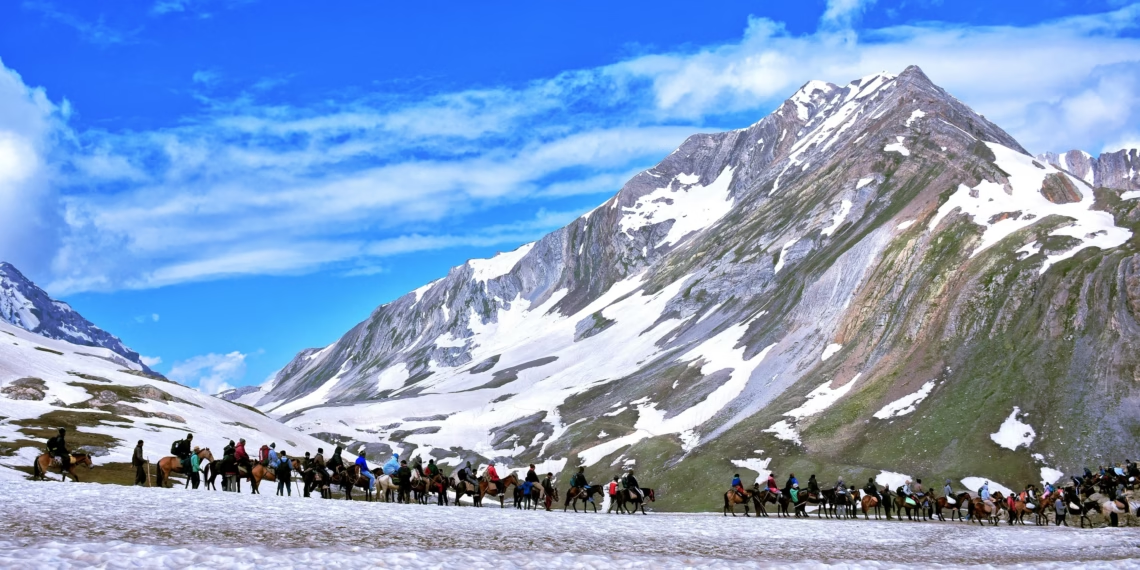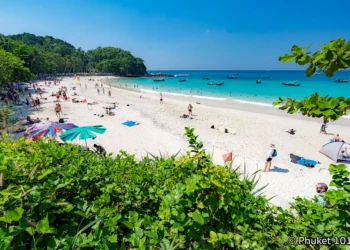High in the Himalayas, where Jammu and Kashmir’s rugged edges meet the sky, lies the Amarnath Cave—a place that’s more than a destination. It’s a journey, a call to the soul, a test of will. Each summer, when the snow softens just enough, pilgrims and seekers set out for this sacred shrine, drawn by the ice lingam said to form naturally within, a symbol of Lord Shiva. The trek isn’t gentle, but it’s profound—mountains tower, rivers roar, and every step feels like a conversation with something ancient.
The Trail Unfolds: A Path of Devotion
The Amarnath Trek isn’t one you stumble into; it begins with intent. Most start from either Baltal or Pahalgam, two routes carved into the landscape, each with its own character. From Baltal, it’s a steep 14-kilometer climb—shorter, sharper, a single day’s push if you’re steady. Pahalgam stretches longer, 36 to 48 kilometers over three or four days, winding gentler but no less demanding. Both paths meet at the cave, 3,888 meters up, where the air thins and the world feels vast.
You’ll feel the altitude early—legs grow heavy, breaths shorten—but the trail has a rhythm. It’s stones underfoot, then mud where snowmelt runs, then patches of ice that catch the unwary. Ponies clop past, their bells a soft chime against the wind, carrying those who can’t walk. The mountains loom—Zojila Pass, Sheshnag Peak—silent watchers over camps like Chandanwari and Pissu Top. I’ve seen pilgrims pause there, hands clasped, eyes tracing the ridges, as if the peaks themselves hold answers.
Suggestion: Start at dawn—light’s kinder then, and the cold bites less. Layers matter—wool, a windbreaker, something waterproof. The routes open June to August; register ahead, and don’t skip the medical check.
Moments Along the Way: Beyond the Climb
The trek isn’t just about reaching the cave; it’s what you find between the steps.
Sheshnag Lake
A day out from Pahalgam, Sheshnag Lake glints at 3,658 meters, its blue-green surface cradled by cliffs. They say it’s guarded by mythical serpents, and the stillness does feel otherworldly. Tents dot the shore at night—stars overhead, the lake reflecting them back. It’s a place to rest, to listen, to let the quiet settle in.
The Sangam
Where the Baltal and Pahalgam paths join, the Sangam feels like a crossroads of effort and faith. The Amarnath River rushes nearby, its waters cold enough to numb your fingers if you dip them. Pilgrims gather here, voices rising in chants—“Bam Bam Bhole”—a sound that carries over the stones. It’s raw, unpolished, alive.
The Cave Itself
The cave looms at the end, wide-mouthed and shadowed. Inside, the ice lingam stands—sometimes tall, sometimes frail, shaped by nature’s hand. You’ll see offerings—flowers, coins—left by those who’ve come before. The air’s damp, the silence thick, broken only by murmured prayers. It’s not grand like a temple; it’s humbler, and that’s its power.
Places to Pause: Rest in the Heights
Accommodation on the Amarnath Trek is basic, shaped by the terrain and the season.
Tented Camps
At stops like Baltal, Sheshnag, and Panchtarni, tents rise each summer—canvas stretched over metal frames, shared by pilgrims. Blankets are thin but warm, and some camps offer tea or dal-rice for ₹100-₹200 a meal. It’s ₹500-₹1,000 a night, a small price for a roof against the wind.
Langars Along the Route
Community kitchens—langars—dot the trail, run by volunteers with open hearts. They serve free food—roti, sabzi, kheer if you’re lucky—hot and simple, a kindness that fuels you. I sat at one near Pissu Top, steam rising from a plate, and felt the warmth spread beyond my hands.
Pahalgam Lodging
Before or after, Pahalgam has guesthouses—wood-walled, with heaters for ₹1,500-₹3,000 a night. They’re modest but steady, a soft landing when the trek’s done.
Food That Sustains: Simple and Strong
The trek’s meals are born of necessity—nourishing, never lavish.
Trailside Stalls
At Baltal or Chandanwari, small setups sell chai, Maggi noodles, parathas—₹50-₹100 for a quick bite. The tea’s sweet, the noodles spiced with whatever’s on hand. It’s not gourmet, but it holds you together.
Pilgrim Fare
Langars aside, vendors near Sangam offer pakoras or khichdi—₹70-₹150—warm against the chill. A handful of walnuts or dried apricots from a pocket keeps hunger at bay between stops.
Pahalgam’s Plates
In town, dhabas serve Kashmiri rogan josh or dum aloo for ₹200-₹300—richer, a reward when the trail’s behind you. Kahwa, green tea with saffron, lingers on the tongue.
Practical Notes: Walking Wisely
Timing It Right: June to August is the window—snow’s melted enough, but storms can still flare. Full moon days draw the most; plan for peace or join the throng.
What to Bring: Boots with grip, a stick for balance, gloves, a torch. Oxygen’s thin up there—pace yourself, sip water, chew ginger if the head spins.
Costs and Papers: Permits are free but mandatory; get them in Srinagar or Jammu. Ponies run ₹2,000-₹3,000 one way, helicopters ₹5,000-₹7,000 from Baltal.
Respect the Place: It’s holy ground—trash stays with you, voices stay low. The cave’s small; don’t linger too long.
Getting Started: Fly or train to Srinagar, then a bus to Baltal (90 km) or Pahalgam (100 km). Roads twist, but the views ease the ride.
Why Amarnath Echoes
The Amarnath Trek isn’t a holiday—it’s a pilgrimage, whether you’re devout or just drawn to the wild. The mountains don’t care who you are; they stand there, immense, as your lungs burn and your feet find their way. I remember a moment near Panchtarni—clouds parted, the peak glowed gold, and a stranger beside me smiled, no words needed. The cave, the ice, the chants—they weave into you. It’s tough, yes—cold seeps in, the path fights back—but that’s why it stays. You leave with blisters, maybe, but also with something heavier, quieter, yours alone.











